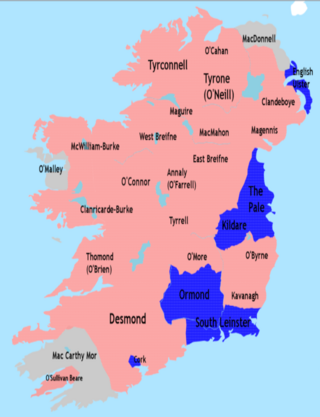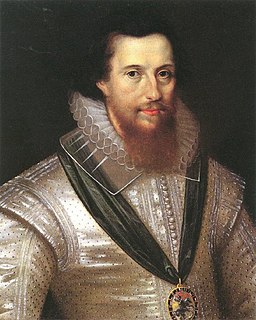| |||||
| Centuries: | |||||
|---|---|---|---|---|---|
| Decades: | |||||
| See also: | Other events of 1599 List of years in Ireland | ||||
Events from the year 1599 in Ireland.
| |||||
| Centuries: | |||||
|---|---|---|---|---|---|
| Decades: | |||||
| See also: | Other events of 1599 List of years in Ireland | ||||
Events from the year 1599 in Ireland.

1599 (MDXCIX) was a common year starting on Friday of the Gregorian calendar and a common year starting on Monday of the Julian calendar. As of the start of 1599, the Gregorian calendar was 10 days ahead of the Julian calendar.

Robert Devereux, 2nd Earl of Essex, KG, PC was an English nobleman and a favourite of Queen Elizabeth I. Politically ambitious, and a committed general, he was placed under house arrest following a poor campaign in Ireland during the Nine Years' War in 1599. In 1601, he led an abortive coup d'état against the government of Elizabeth I and was executed for treason.

Richard Boyle, 1st Earl of Cork, also known as the Great Earl of Cork, was an English politician who served as Lord Treasurer of the Kingdom of Ireland.

Hugh O'Neill, was an Irish Gaelic lord, Earl of Tyrone and was later created The Ó Néill Mór, Chief of the Name. O'Neill's career was played out against the background of the Tudor conquest of Ireland, and he is best known for leading the resistance during the Nine Years' War, the strongest threat to Tudor authority in Ireland since the revolt of Silken Thomas.

The Nine Years' War, sometimes called Tyrone's Rebellion, took place in Ireland from 1593 to 1603. It was fought between an Irish alliance—led mainly by Hugh O'Neill of Tyrone and Hugh Roe O'Donnell of Tyrconnell—against English rule in Ireland, and was a response to the then-ongoing Tudor conquest of Ireland. The war was fought in all parts of the country, but mainly in the northern province of Ulster. The Irish alliance won some important early victories, such as the Battle of Clontibret (1595) and the Battle of the Yellow Ford (1598), but the English won a decisive victory against the alliance and their Spanish allies in the siege of Kinsale (1601–02). The war ended with the Treaty of Mellifont (1603). Many of the defeated northern lords left Ireland to seek support for a new uprising in the Flight of the Earls (1607), never to return. This marked the end of Gaelic Ireland and led to the Plantation of Ulster.

Frances Burke, Countess of Clanricarde and Dowager Countess of Essex was an English noblewoman. The daughter of Sir Francis Walsingham, Elizabeth I's Secretary of State, she became the wife of Sir Philip Sidney at age 16. Her second husband was Queen Elizabeth's favourite, Robert Devereaux Earl of Essex, with whom she had five children. Two years after his execution in 1601, she married Richard Burke, Earl of Clanricarde, and went to live with him in Ireland.

The Battle of Curlew Pass was fought on 15 August 1599 during the campaign of the Earl of Essex in the Nine Years' War, between an English force under Sir Conyers Clifford and a rebel Irish force led by Aodh Ruadh Ó Domhnaill. The English were ambushed and routed while marching through a pass in the Curlew Mountains, near the town of Boyle, in the west of Ireland. The English forces suffered heavy casualties. Losses by allied Irish forces were not recorded but were probably minimal.

Essex in Ireland refers to the military campaign pursued in Ireland in 1599 by Robert Devereux, 2nd Earl of Essex, during the Nine Years War.

Sir Richard Bingham was an English soldier and naval commander. He served under Queen Elizabeth I during the Tudor conquest of Ireland and was appointed governor of Connacht.
Events from the 1480s in England. This decade marks the beginning of the Tudor period.
Events from the 1590s in England.
Events from the 1600s in England. This decade marks the end of the Elizabethan era with the beginning of the Jacobean era and the Stuart period.
Events from the year 1600 in Ireland.
Events from the year 1598 in Ireland.

Frances Seymour, Duchess of Somerset, was an English noblewoman who lived during the reigns of Elizabeth I, James I, Charles I and Charles II. Her father was Robert Devereux, 2nd Earl of Essex, Elizabeth I's favourite who was executed for treason in 1601. She was the second wife of William Seymour, 2nd Duke of Somerset, and the mother of his seven children.
Brian Oge O'Rourke, c. 1568 - 28 January 1604, was the penultimate king of West Breifne, from 1591 until his overthrow in April 1603, at the end of the Nine Years' War. Due to the successive deaths of both his older brother Eoghan in 1589 and his father Brian O'Rourke, who was executed in London in 1591, Brian Oge was thrust into the leadership of his kingdom at just 23 years old. In 1599, O'Rourke's forces fought alongside those of Hugh Roe O'Donnell at the Battle of Curlew Pass, during the Nine Years' War. His forces, along with those of Hugh O'Neill, 2nd Earl of Tyrone, were still sufficiently menacing to Queen Elizabeth I that she was persuaded to agree to a peace in Ireland - the Treaty of Mellifont.

Sir Conyers Clifford was an English politician and military commander.

Tibbot na Long Bourke, anglicised as Theobald Bourke, was an Irish peer and parliamentarian. A prominent member of the MacWilliam Burkes of County Mayo, Tibbot was a Member of the Irish House of Commons and was later created the first Viscount Mayo. His successful life followed, and usefully illustrates, the difficult transition for Irish aristocrats from the traditional Gaelic world during the Tudor conquest of Ireland.

Essex's Rebellion was an unsuccessful rebellion led by Robert Devereux, 2nd Earl of Essex, in 1601 against Queen Elizabeth I of England and the court faction led by Sir Robert Cecil to gain further influence at court.